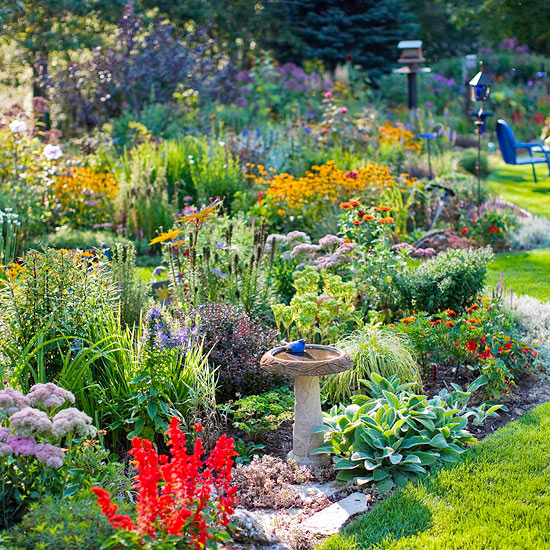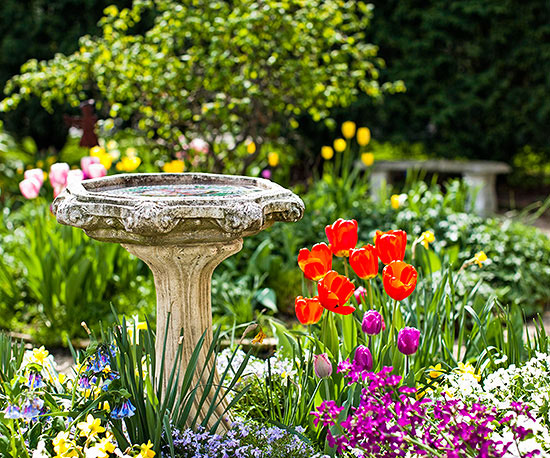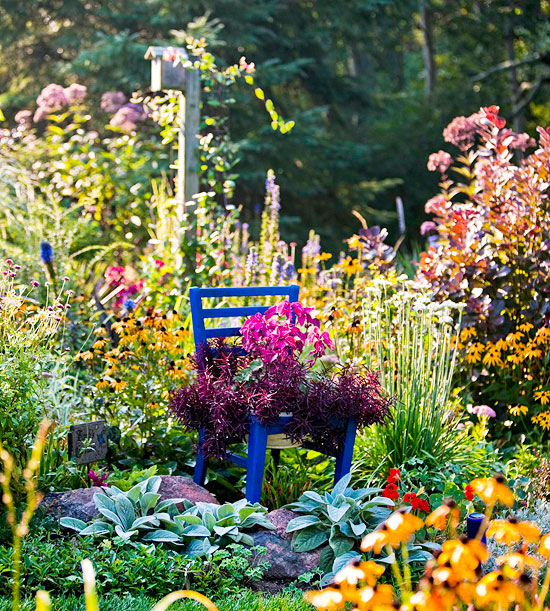





Part of the beauty of any landscape is its ability to feed and shelter wildlife -- and that includes attracting songbirds to the garden. Implement just one of these tips, or a few or all of them as time allows, to maximize the winged visitors to your outdoor spaces.
continue reading below
Attracting songbirds to the garden means opting for a solidly packed, multilayer landscape that has an array of plants to supply structure and food throughout the year. When designing and planting beds and borders, think both horizontally and vertically and include a range of plants, from annuals to perennials, herbs, vegetables, and grasses. For example, the seed heads of perennials and ornamental grasses draw fall ground-feeding birds and supply cover for birds as they forage on the ground.
Love wildlife? Try your hand at cultivating bees with a beehive.
To draw birds in, find a seed or food that is specific to the birds you want to attract. In addition, you'll draw a more interesting variety of birds than you would with a general wild bird blend. For starters, try an assortment of seed- or nectar-producing plant species that are known to please songbird palates, including black-eyed Susan, coneflower, coreopsis, and salvia. Or fill bird feeders with sunflower seeds, which are a good basic for attracting songbirds to the garden (and a favorite of most seed-eating birds). Suet and mealworms attract insect-eating birds such as nuthatches and woodpeckers; cracked corn draws pigeons and doves. For goldfinches, indigo buntings, and towhees, include a finch mix; finches also love nyjer seeds. Songbird mix draws cardinals, titmice, blue jays, and white-throated sparrows, among others, while safflower attracts songbirds but isn't as attractive to squirrels, starlings, and grackles. Hummingbirds visit feeders with sugar and water, as do orioles, house finches, and red-bellied woodpeckers; you can also set out fresh fruit halves for orioles, tanagers, and grosbeaks.

Birds love to splash in water, so including a birdbath is a good method to attract songbirds. Place the birdbath in an open location so the birds can keep an eye on their surroundings and watch for potential predators; change the water every few days.
As a tool for attracting songbirds to the garden, native plants provide a balanced diet of seeds and fruits that ripen at critical times. The more natives you plant, the more insects you draw, and the more varieties of songbirds that will visit.
Find native plants for your region.
Trees and shrubs provide shelter from storms and hiding places from predators. Plus, trees and shrubs supply a spot for birds to build a nest, which is helpful in attracting songbirds to the garden. Trees that bear fruits and nuts, such as flowering crabapple, also offer food to many songbirds. Include several specimens for as much variety as possible. Include at least one thorny species, such as hawthorn or rose, to provide protective perches. A few dense evergreens (juniper, spruce, yew) offer winter cover; a variety of berry-producing species such as dogwood, serviceberry, chokeberry, and viburnum provide fruit at different times in the season. Bonus: Many trees are also attractive to butterflies.
A yard with fewer square feet devoted to turf and more space with wildlife-attracting landscape will naturally have more songbirds. For native grasses, good choices for attracting songbirds to the garden include switchgrass and little bluestem; cut them back once per year in early spring.
Instead of cutting perennials to the ground in autumn, leave stems to help shelter overwintering insects that songbirds may eat. You may also leave brush piles from cleanup chores. These fallen branches are great ground-level shelter for birds.
Note: Leaving brush piles may attract and provide habitat for other wildlife, such as rodents.

Feeders and birdhouses are great tools for attracting songbirds to the garden, but you must keep them in good shape. Clean feeders monthly to keep free of disease-causing bacteria; use a solution of 1 part bleach to 9 parts water. Clean out and repair boxes in late winter before nesting season begins.
Any of these substances can be deadly to birds and other wildlife. A better bet to attracting songbirds to the garden is to rely on biological controls for insect pests and keep weeds down by pulling them when they are small and before they have a chance to go to seed.
Your felines may want to roam, but cats cause the death of millions of songbirds each year. Your best bet for attracting songbirds to the garden is to separate the two.
Learn more about cats in the garden.
Copyright © www.100flowers.win Botanic Garden All Rights Reserved